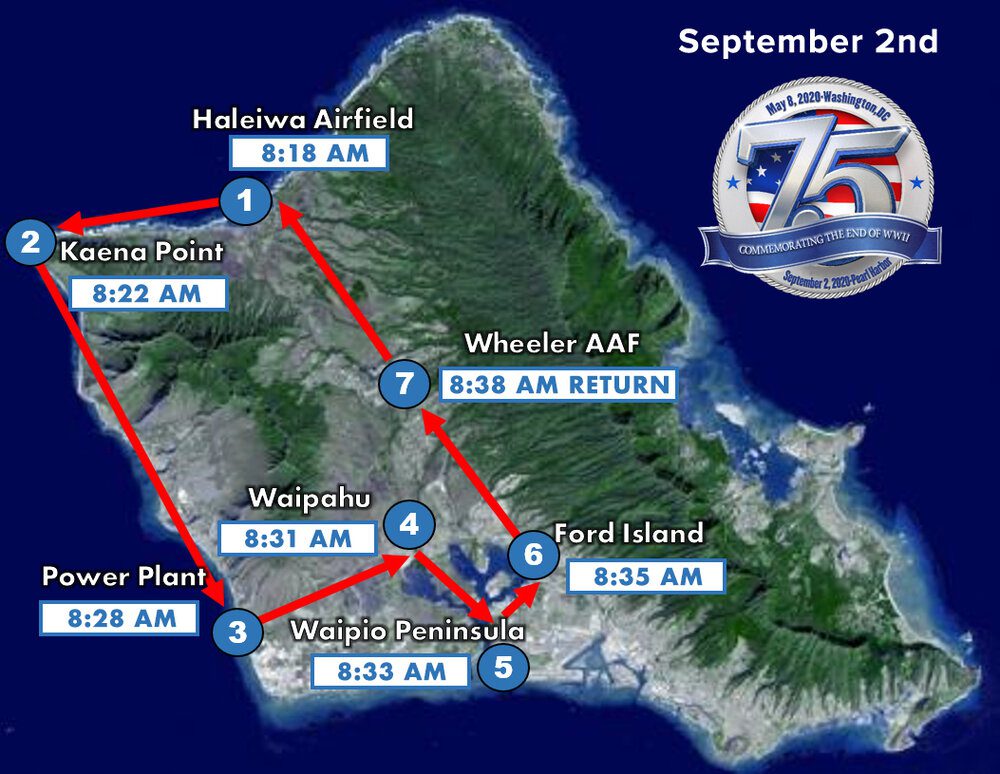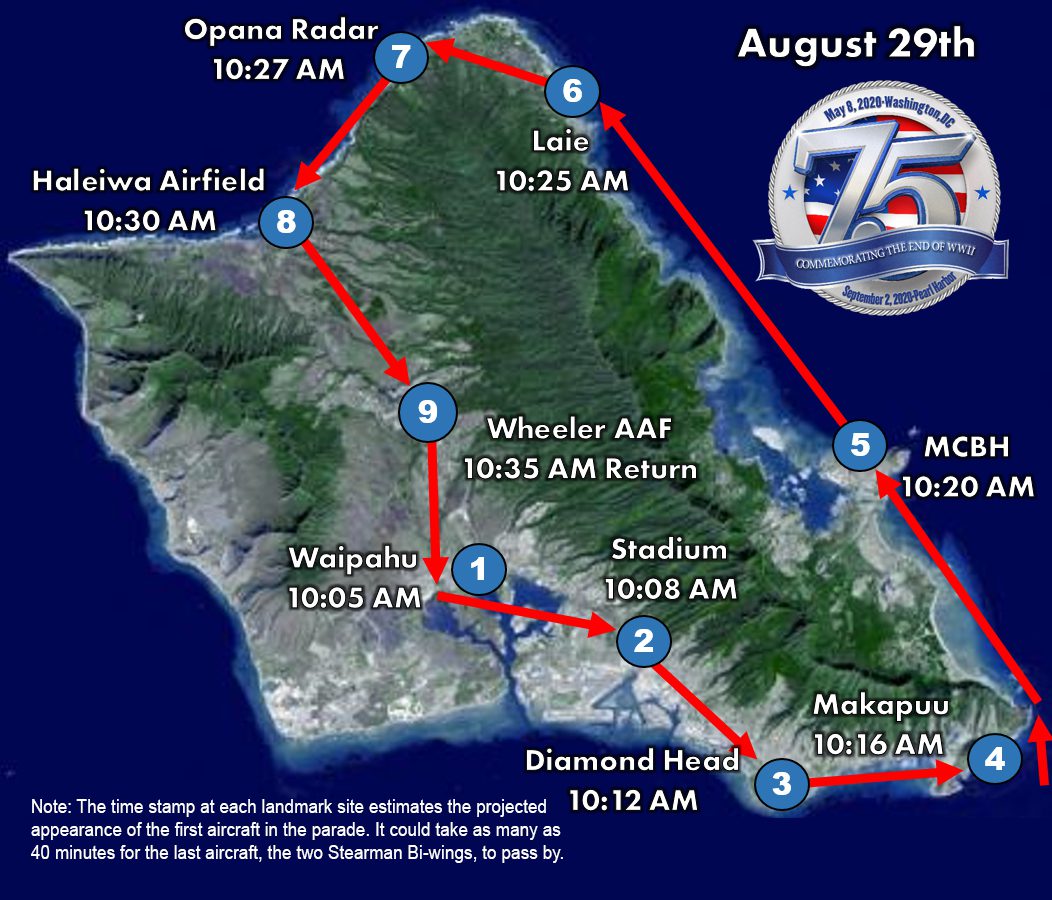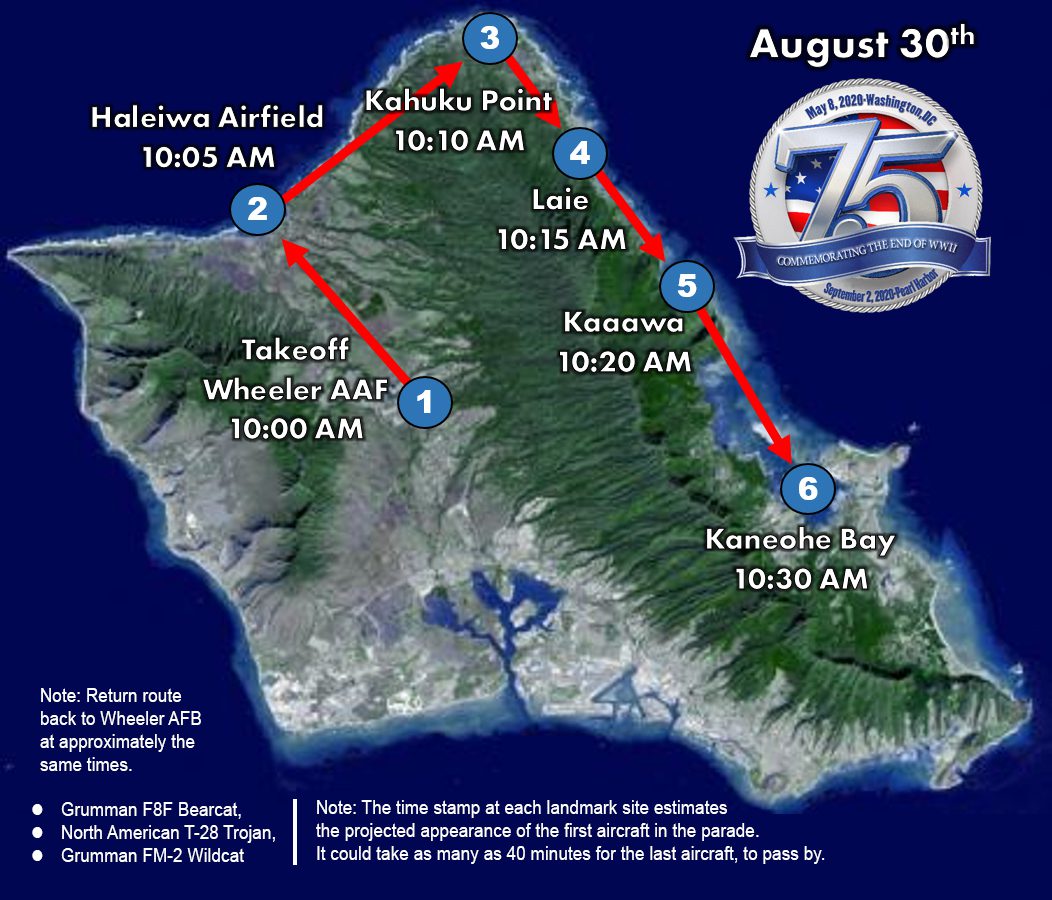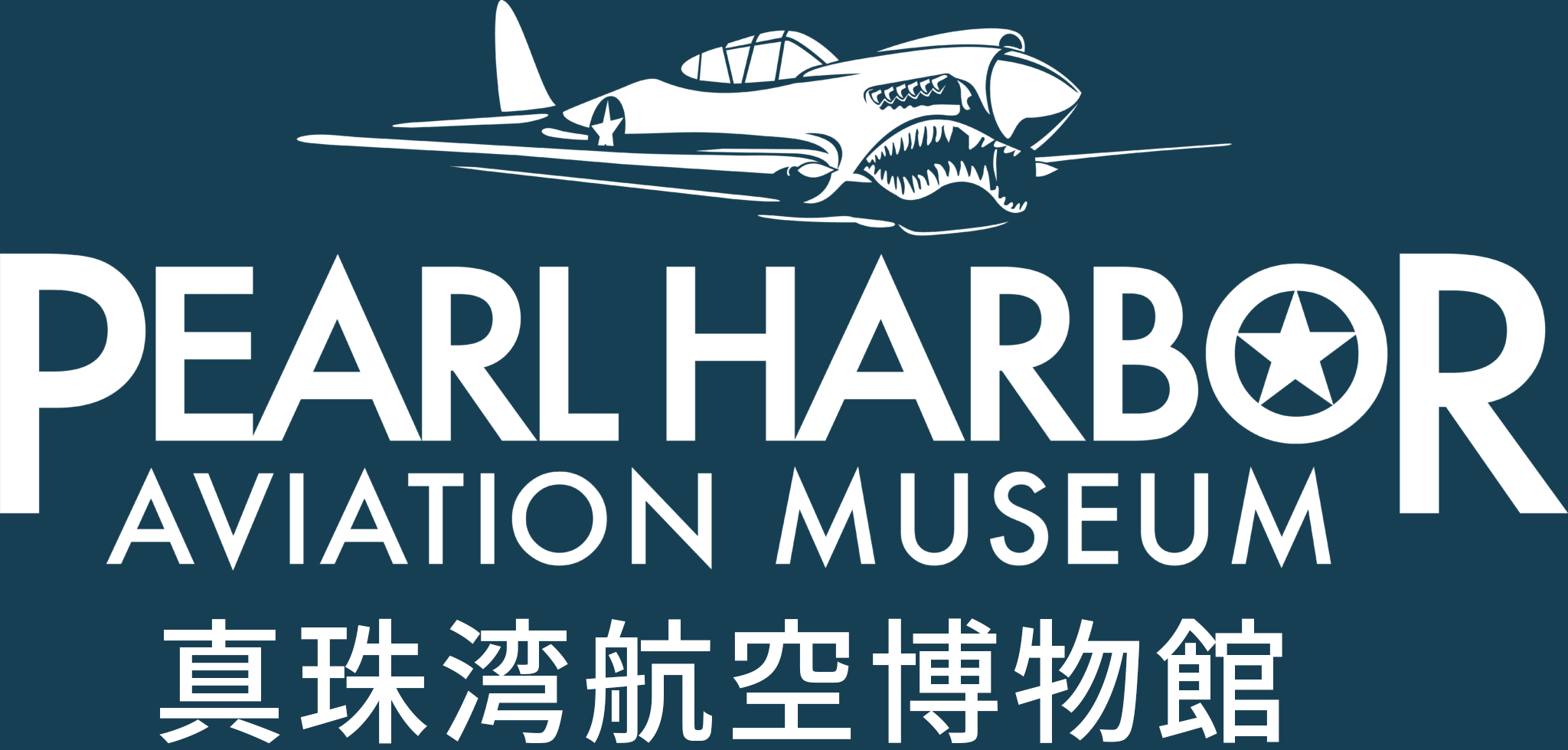Join us for aerial parades around Oahu to commemorate 75 years since the end of World War II.
Wednesday, September 2nd
The Legacy of Peace Aerial Parade will take off from Wheeler Air Force Base and fly over the Battleship Missouri Memorial as part of the 75th WWII Commemoration Ceremony.
The Official 75th Commemoration of the End of WWII will be held on the Fantail of the USS Missouri. This event is invitation-only and will be live-streamed throughout Hawaii and around the globe. Click here to learn where to watch it live.

Note: The timestamp at each landmark site estimates the projected appearance of the first aircraft in the parade. It could take as many as 40 minutes for the last aircraft to pass by.
Saturday, August 29th


Sunday, August 30th


Use these descriptions to spot and identify the warbirds as they fly past, and learn a bit more about their service in World War II and beyond.
North American SNJ-5/AT-6 Texan:
The North American SNJ/AT-6 Texan was the most widely used advanced training aircraft in the Allied inventory. Texans were used by most Allied nations to train their combat pilots, who commonly referred to it as the “Pilot Maker” due to this role. In this aircraft pilots learned skills such as instrument flight, formation flight and aerial combat maneuvering. Due to these training programs, most, if not all, American and Allied pilots had flying time in the Texan. Here on Oahu they were a familiar sight during the war and after, regularly taking off from Wheeler AAF and Hickam Field as pilots continued to get their flight time.
North American P-51:
The North American P-51 Mustang is one of the most well-known American-built fighters of WWII. Built as a long-range, high altitude fighter, the Mustang excelled at both long-range bomber escort and low level strafing runs. The Mustang became well known for escorting the B-17 Flying Fortresses over Europe and as the first escorts to make it to Berlin in 1944. It was also the favored fighter of the 332nd fighter group known as “The Red Tails,” the famed squadron of the Tuskegee Airmen. In the Pacific, the Mustang escorted B-29 Super Fortresses from Iwo Jima over Japan toward the end of the war. After WWII, the Mustang continued its flying service in the Korean War.
Grumman TBM-3 Avenger:
The TBF/TBM Avenger was the primary U.S. Navy torpedo bomber in WWII and continued its service through the 1960s. The Grumman Aircraft Corporation had a ceremony to show its new torpedo bomber on December 7, 1941, at the Grumman plant in New York. During this ceremony word arrived of the attack against the Naval Base at Pearl Harbor. After a month or so of testing, the new aircraft received the nickname “Avenger.” The first Avengers were delivered to the Pacific Fleet in early 1942. It saw its first combat in June 1942 at the Battle of Midway, where six Avengers participated. Unfortunately five of the six were lost and the last one was severely damaged. Even with this hard fought first fight the Avenger went on to be present at most major battles of the Pacific Theater from Midway till the end of the war, where it participated in the Surrender Ceremony, proudly living up to the name it was given in the first months of the war.
Boeing-Stearman Model 75:
The Boeing Model 75 commonly referred to as the Stearman or “Kaydet” was the most widely used primary training aircraft for the United States in WWII. It was the initial primary training aircraft for both the U.S. Navy and U.S. Army. The Navy designated the Model 75 as the NS and N2S while the Army gave it the designation PT-13 and PT-17. Over 10,000 units were built in its production run from 1934 until the end of WWII. After the war a large number of Model 75s were sold on the civilian market, many becoming crop dusters and aerobatic demonstrators. There are still hundreds flying today throughout the United States.
Grumman F8F Bearcat:
The Grumman F8F Bearcat was a single engine fighter that was built for speed and agility. It essentially took the airframe of the F4F Wildcat and put the massive engine of the F6F Hellcat on the front. To cut weight it had manual folding wings and a tail hook; this meant upon landing on an aircraft carrier, the deck crew had to manually lift the tail hook into position and use a large pry bar to fold the wings in and back. The design was laid down in 1943, testing in 1944-45, and delivered to the fleet shortly after WWII had ended, meaning it had not seen combat in WWII. Though it missed combat it is still considered one of the best fighter designs presented during the war putting together characteristics of speed, agility, fast rate of climb, and superior visibility out of the cockpit. After the war was over the Bearcat became the second airframe used by the U.S. Navy demonstration team, the Blue Angels. Though Bearcats never saw combat with the U.S., they did see combat with the French Air Force in the 1950s in their war in Indo China (Vietnam).
Grumman FM2 Wildcat:
The FM-2 is a later variant of the F4F Wildcat; these aircraft were built under contract by the General Motors Company giving them the FM designation over the Grumman F4F designation. The FM-2 differed from the F4F in that it was lighter, faster and more maneuverable than the previous variants. They were also designed to be based off of the smaller “Jeep” escort carriers instead of the larger fleet carriers which were now fielding F6F Hellcats. The Wildcat in all variants, from the F4F to the FM, is the only U.S. Navy fighter aircraft to serve during the entire war from Pearl Harbor to the surrender in Tokyo Bay. Due to this long combat service many Wildcat pilots were awarded the Medal of Honor, including Marine Corps Captain Joe Foss (Guadalcanal Campaign) and LTJG Butch O’Hare (Bougainville area) who also became the first Ace fighter pilot of WWII from the U.S. Navy.
Consolidated/Boeing Canada PBY Catalina:
The Consolidated Vultee PBY Catalina, also known as the Canso in service with the Royal Canadian Air Force (RCAF), is a flying boat, and later an amphibious aircraft, which could take off on land or sea. The Catalina was primarily used for long range patrol and reconnaissance missions. Another mission of this aircraft was that of search and rescue. With the large distances between land masses in the Pacific Ocean the Catalina was essential in tracking down the enemy forces as well as recovering downed aircrews. Though it joined the U.S. Naval fleet in 1936, it continued to serve throughout WWII and was finally retired from U.S. Naval service in 1957. On December 7, 1941, many of the Pacific Fleet’s PBYs were destroyed by the Imperial Japanese Raid on Pearl Harbor. In fact of the 33 Catalina aircraft at NAS Kaneohe only six were serviceable by the end of the day. Six months later on June 3, 1942, a PBY known as Strawberry-5 was the first US aircraft to detect the Imperial Japanese fleet as it approached the Midway Atoll.
North American B-25 Mitchell:
The North American B-25 Mitchell was a medium bomber of the U.S. Army Air Forces. The Mitchell entered service in 1941 and flew with almost all Allied air forces. It also served in every theater of operations during the war. One of the most well-known missions the Mitchell was featured in was the Tokyo Raid of April 18, 1942. For this mission the U.S. Army modified 16 Mitchell bombers to be able to take off from a U.S. Navy aircraft carrier the USS Hornet. After stripping out the armor and armaments of the aircraft they then installed modified internal fuel tanks and a limited amount of bombs to increase the range of the aircraft. In early April 1942 the 16 aircraft were loaded onto the USS Hornet and they set sail. When still about a day out from the launch point, the fleet was spotted by a picket ship which may have been able to radio in the position of the carrier. At this time the decision was made to launch the aircraft from around 600 miles out from the target instead of the intended 400-450 miles out. Knowing that they had barely enough fuel to complete the flight the aircrews launched and headed toward the targets of Tokyo, Yokohama, Yokosuka, and other military sights. All 16 made it over target and continued to the landing point in unoccupied China. One aircraft had a fuel shortage and landed in Vladivostok Russia while the other 15 crash landed on the coast line of China. Of the 80 crew members that left on the top secret mission 73 were able to make it back alive.
Globe Swift GC-1B:
The Globe Swift GC-1B is a two seat, mono-wing sport plane produced just after WWII ended. The design phase was started in 1940, but with the U.S. introduction to the war the civilian aircraft industry came to a halt and switched to military design. Throughout this time, Globe continued to design and enhance what would become the GC-1 Swift. After the war came to an end the aircraft got certified and production began in 1946, with a total of just over 1,500 being built of the A and B variants.

